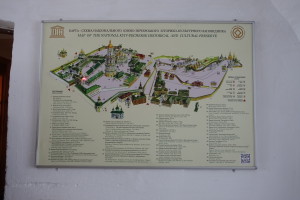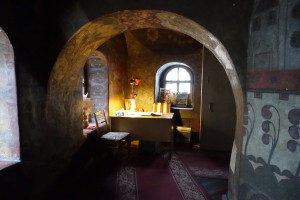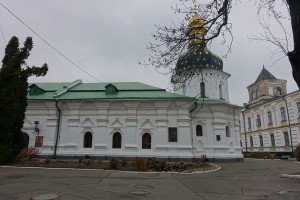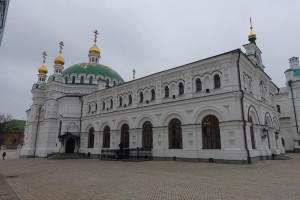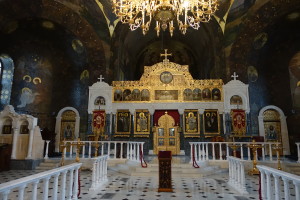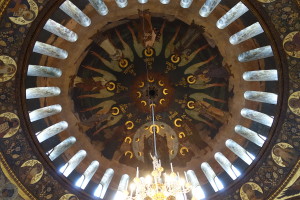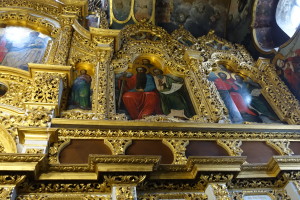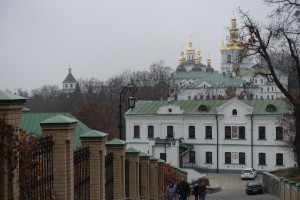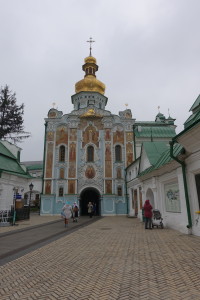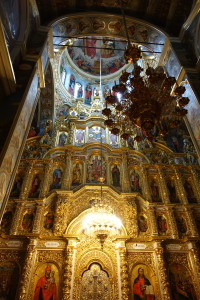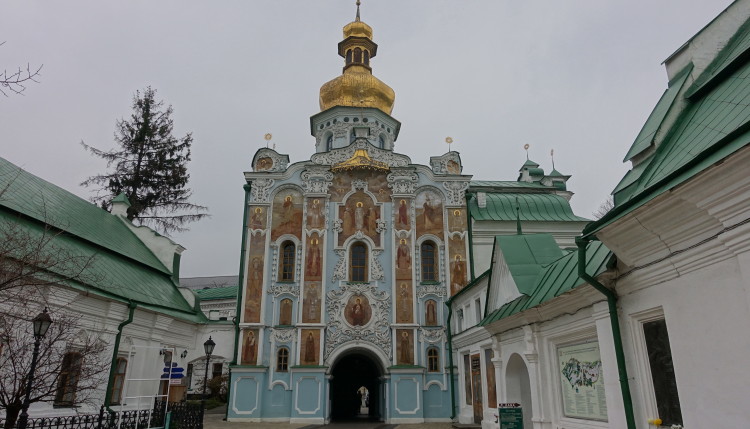
Kyiv Pechersk Lavra – Pearl of Ancient Rus (Russia)
The highlight of my visit to Kyiv is Kievo-Pecherskaya Lavra. After leaving the Park of Eternal Glory on the hillside bank of the Dnieper River, the shining golden domed monastery site, Kievo-Pecherskaya Lavra. beckoned to us. Upon stepping through the gate, one could almost feel the quiet presence of all the saints that walked these cobbled streets over the past thousand years. How many prayers and petitions went up to God right here? It was as if the “incense” of their prayers still lingered in the air. Just as David prayed in the Old Testament Psalms:
Psalm 141:2, “May my prayer be counted as incense before You; The lifting up of my hands as the evening offering.”
Similar to Rome, Jerusalem and Constantinople, Christians from all over the world make their pilgrimages to this monastery site. Almost two thousand years ago the Apostle Andrew preached God’s Word in the Scythian Land (right here) and foretold of many churches glorifying God in “Ancient Rus” while he blessed this site. His vision of this site, and the miraculous visions received by others, became the catalyst in which an Orthodox Christian monk, Anthony, founded the monastery, Kievo-Pecherskaya Lavra.
At one time the Lavra included 100 buildings (42 unique) with 23 temples (6 cave temples) and 36 altars encompassing a 300,000 square meter site–considered the preeminent center of Eastern Orthodox Christianity in Eastern Europe.
The Upper Lavra is the area of the hillside containing the cave monasteries Three separate gates provide entrance into Kievo-Pecherskaya Lavra: the Economic Gate, the Main Gate of the Lower Lavra and the Gate Church of the Holy Trinity.
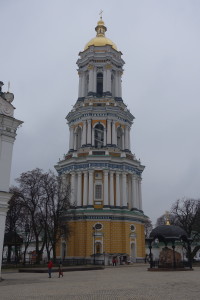
The main street of the Upper Lavra leads to the “Great Bell Tower of Lavra”–this tower is seen from miles away.
In 1051 Reverend Anthony (sent from an ancient monastery located on Mt Athos, Greece) journeyed to Kyiv Rus to pray and teach the new Christians in this area. Following a similar lifestyle in which he lived as a monk in Mt Athos, he chose to carve and then live inside a 4 square meter cave “perchera”, the first of the “Varangian Caves” and part of the “Far Caves.” Word spread. Other monks joined Reverend Anthony in this simplistic cave monastery to pray and learn of God. During Anthony’s time in the Lavra, royal nobility visited this site (as foretold by the Mother of God) and provided funds to build a ground temple and monastery (Kievo-Pecherskiy) for this growing brotherhood of monks.
After twelve monks joined him in the “cell” caves (one connecting to another though corridors of tiny space) with a temple built, the Reverend Anthony left the other monks to carve himself a new cave, on another slope, where he then spent his next forty years. Prior to his death at the age of 90 he asked that his burial in a particular cave be kept secret. (Reverend Anthony became the first of 150 monks buried in the caves over a 700 year period.)
Hearing his life story I thought a lot about what it meant to dig a cave in which to live very simply (mostly alone) and spend my time in quiet solitude and prayer. Here inside these small dark caves with no sounds, sights, smells or even the distraction of “time” itself, Anthony spent much of his life talking to God. Twelve other men felt too crowded. I wonder, did they keep him from prayer? What would he think about the many distractions in our lives today?
While walking inside the cramped quarters of one of the caves open to the public I felt the overwhelming holiness of this site. Shoulder to shoulder with other people (each of us holding thinly tapered “lit” candles) we walked single file into the caves. Sometimes only 3 feet across and perhaps about 6 feet tall the dimly lit corridors led from one small “cell cave” to another. Several glass caskets placed inside a few of the cells revealed the incorruptible bodies of the Saints. I stood looking at the skin of the hands folded in prayer–a visible miracle, God’s preservation of the body of a saint. Reading about this and seeing it in person are entirely different. (Unable to take photos inside the holy burial cave I have none to post.)
Entrance into the Lavra through the “Economic Gate” (the one I used) leads into the “Church of All the Saints”.
“Church of the Savior in Berestov” was under repair with no admittance at this time.
The area of the Lavra winds around, up and down the hillside of the Dnieper River.
The “Hospital Monastery” dates back to the 12th century in ancient Rus when the first prince (Prince Svyatosha) took monastic vows and became “Venerable Nicholas”. He built the Church of the Holy Trinity over the Holy Gate of Lavra and arranged a hospital here in this area of the Upper Lavra.
Devastation from fires, bombs during wars and deliberate destruction by Soviet Russia in the early 20th century left some of this original church destroyed. During both Russian and German occupations worship inside the Lavra was illegal. The original refectory honored the Apostles Peter and Paul. Russia relegated it to a mere cinema. Then, after bombs destroyed pillars and the walls cracked Nazis removed the roof and closed the area. In 1990 services finally resumed following the restoration of the Lavra.

Portion of the Remaining Wall from the Lavra in the 11th century: proof of the excellence of the original architects.
“Church of Saints Anthony and Theodosius of the Caves with the Refectory Chamber” is the largest sanctuary in the Lavra.
My senses were already on “overload” but even more so in this exquisite sanctuary. With time constraints and so much to see and experience, it was difficult knowing where to focus my attention. Each panel, icon, ceilings and paintings seemed to beckon to me. I whispered “wow” over and over.
This next church, the “Great Church of the Holy Dormition” is central to the entire Lavra. Repeatedly destroyed and rebuilt, the last bombing took place on November 3,1941 when the miraculous icon of Dormition of the Holy Virgin disappeared. (It is said that it was given to the architects of the Lavra by the Mother of God in Constantinople during the mid 11th century.)
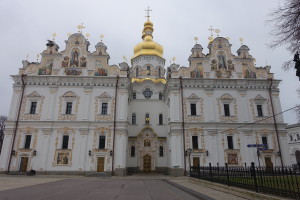
Great Church of the Holy Dormition is one of the main shrines of the monastery
During construction, and during each restoration, the details of each Icon was painstakingly painted by numerous talented monks.
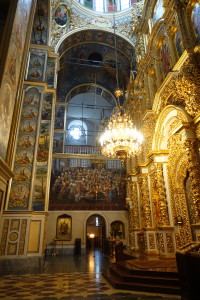
The height inside these cathedrals–scaffolding was used for monks to stand upon while painting every inch of this church.
Just like the cathedrals, the streets and walkways are beautifully maintained. Libraries, a printing house, medical facilities, kitchens and dining halls, and economic buildings make up some of the buildings inside the Lavra. Though some are now museums most retain their original purpose. (A few small outdoor “shops” sold scarfs, umbrellas and Ukrainian momentos–small reminders of visiting the Lavra. I looked in several shops for “English books, or music” and something special to remind me of this place. I found a cross with Michael the archangel on one side–blessed by one of the Lavra monks–to wear around my neck and to remind me to pray for the Ukraine.
Many great Russian chronicles were written at the monastery–the first such chronicler, Venerable Nikon (Father Superior of the Pechersky Monastery) wrote the famous “Russian Primary Chronicle” in 1113.
The Assumption Cathedral took 15 years to build. Venerable Alypios, (considered the founder of the Russian manner of icon painting) and Greek style painters participated in decorating this Cathedral.
Though the October 1917 revolution triggered terrible destruction at Kievo-Pecherskaya Lavra, it survived. Though many monks were shot and others suffered imprisonment or exile the Lavra remains a sacred place for worship.
I pondered the differences between this site and those I visited just one week earlier while in Istanbul (such as the Blue Mosque). Without any iconic images, paintings or statues, perhaps the stark blank walls of the mosques are meant to minimize distractions? The Blue Mosque is covered in blue painted tiles with high domed ceilings but there is no altar, no cross to fix my eyes upon. But, it isn’t the outward differences I noticed most. It is in the eyes of the people in each. The warm smiles of Christian monks and nuns are absent in the leaders of Islam. Instead of a required loud“call to worship” by a muezzin six times each day, the monks here chose to enter quietly and maintain a private solitary life of prayer and humility before God.
Jesus gives life “so we might have it more abundantly.” There is nothing we need to do but accept the gift of salvation. Very simply, our eternal life comes just by acknowledging our need for a Savior. We can’t do it on our own. Jesus, the Son of God Himself, stands ready to forgive us our sins and welcome us into His arms.
Ukrainians suffered greatly during numerous years of wars, conflicts and persecutions. Sanctuaries were destroyed, rebuilt and destroyed again. A thousand years before Kyiv became a city for Christ, Constantinople thrived as the center of the early Christian church. At the same time Kyiv grew stronger in its faith and knowledge of Jesus, Constantinople replaced its faith with that of the Islamic prophet Mohammed. How, and more importantly, why did this happen? I wonder, what changed inside their hearts to move them towards or away from Jesus?
Jeremiah 17:10 “I the LORD search the heart and test the mind, to give every man according to his ways, according to the fruit of his deeds.”
Since God alone knows the hearts of men, what does he know about me? And, what about the future of my own country? Once considered a “Judeo-Christian” nation, who or what are we now? As the Lord searches my heart and tests my mind, I pray He knows how much I love Him. I desire to follow His path set before me but, like the apostle Paul who wrote in his letter to the Romans, I fail often. Paul wrote:
Romans 7:15 “For I do not do what I want, but I do the very thing I hate.”
It’s hard to imagine Paul, one of the greatest Saints in all Christianity, struggling with doing the very things he hates–actually, struggling. Paul continues writing to provide me with the answer, and a promise:
Romans 8:1-2, “There is now no condemnation for those who are in Christ Jesus. For the law of the Spirit of life in Christ Jesus has set you free from the law of sin and of death.”
Whether alone in a cave, together with fellow worshippers inside a beautiful sanctuary, or in the midst of a crowd of strangers in a strange land, I am securely held by Christ. I am not condemned, I am forgiven, I am loved.
Romans 8: 37-39, “In all these things we are more than conquerors through Him who loved us. For I am convinced that neither death, nor life, nor angels, nor principalities, nor things present, nor things to come, nor powers, nor height, nor depth, nor any other created thing, will be able to separate us from the love of God, which is in Christ Jesus our Lord.”

